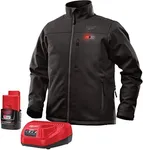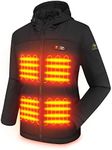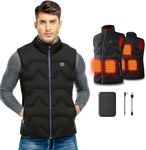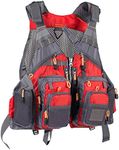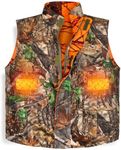Buying Guide for the Best Heated Jackets
Heated jackets are a great investment for those who spend a lot of time outdoors in cold weather. They provide warmth through built-in heating elements, which can be powered by rechargeable batteries. When choosing a heated jacket, it's important to consider several key specifications to ensure you get the best fit for your needs. Here are the main factors to consider:Heating ZonesHeating zones refer to the areas of the jacket where the heating elements are located. Common zones include the chest, back, and sometimes the sleeves. More heating zones can provide more comprehensive warmth, but they may also use more battery power. If you need targeted warmth, look for jackets with heating zones in the areas where you feel the cold the most.
Battery LifeBattery life indicates how long the jacket can provide heat on a single charge. This is important because it determines how long you can stay warm without needing to recharge. Battery life can range from a few hours to over 10 hours, depending on the heat setting and battery capacity. If you plan to be outdoors for extended periods, look for a jacket with a longer battery life or consider carrying a spare battery.
Heat SettingsHeat settings allow you to adjust the level of warmth provided by the jacket. Most heated jackets offer multiple settings, such as low, medium, and high. This feature is important because it lets you customize the heat output based on the weather conditions and your personal comfort. If you need flexibility, choose a jacket with several heat settings.
Material and InsulationThe material and insulation of the jacket affect its overall warmth and comfort. Common materials include polyester, nylon, and softshell fabrics, which can be water-resistant and windproof. Insulation, such as down or synthetic fill, adds extra warmth even when the heating elements are off. If you need a jacket for harsh weather, look for durable, insulated materials that provide both warmth and protection.
Fit and SizeThe fit and size of the jacket are crucial for comfort and effectiveness. A well-fitted jacket ensures that the heating elements are close to your body, providing optimal warmth. Heated jackets come in various sizes and styles, including slim fit and relaxed fit. To choose the right one, consider your body shape and how you plan to layer clothing underneath the jacket.
Control and ConnectivitySome heated jackets come with advanced control options, such as smartphone apps or remote controls, allowing you to adjust the heat settings without taking off the jacket. This feature can be convenient, especially if you need to change the settings frequently. If you value ease of use, look for jackets with user-friendly control options.
Safety FeaturesSafety features in heated jackets include automatic shut-off and overheat protection, which prevent the jacket from getting too hot and causing burns or discomfort. These features are important for ensuring safe use, especially if you plan to wear the jacket for long periods. If safety is a priority, choose a jacket with built-in safety mechanisms.

